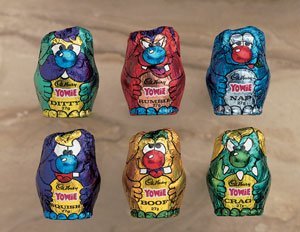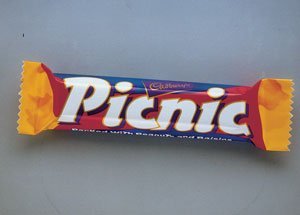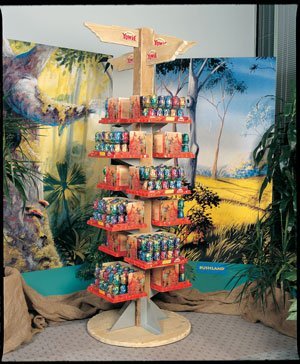
This case study examines an exciting new product idea from Australia – the Yowie – and shows how it is a good example of Cause Related Marketing. Everyone is familiar with Cadbury’s Dairy Milk – it is one of the nation’s favourite chocolate products. In Australia, Cadbury Schweppes has found a way of adding more value to Cadbury’s Dairy Milk.
This has been done by shaping and packaging the chocolate into fun characters, known as the Yowie, in such a way as to fuel a vast consumer interest. In addition, the product has been paired with a key area of consumer concern and interest – the environment – by combining the product with educational content, such as theme-related toys, books and CDs.
What is cause related marketing

Marketing is ‘the management process responsible for identifying, anticipating and satisfying customer or consumer requirements profitably’. Marketing involves finding out exactly what the customer or consumer requires and then providing goods and services in a way that delights them. In essence, this involves providing the best possible marketing mix, i.e. the right goods, at the right time, in the best possible places and with the most desirable level of promotional activity. Today, the term social marketing is used to refer to the way in which modern marketing is concerned with meeting the wider needs of the society in which business operates. Social marketing recognises that consumers’ brand requirements are important but it also takes into account the needs and expectations of the wider community. Cause Related Marketing has become an important ingredient of this marketing mix.
Cause Related Marketing is a commercial activity by which businesses and charities (or causes) form a partnership with each other to market an image, product or service for mutual benefit. It is a marketing tool used to help address the social issues of the day, by providing resources and funding, whilst at the same time addressing important business objectives. Examples of Cause Related Marketing in the UK include a partnership by Cadbury Limited and Save the Children which raised funds for Save the Children and focused community programmes to the benefit of Cadbury’s corporate image. Another good example from the retailing industry is Tesco’s ‘Free Computers for Schools’ which is based on parents and friends of schools collecting vouchers in proportion to the amount of money they spend in Tesco stores. When Cause Related Marketing works well, everyone wins – the company, the cause and the consumer. In business terms, this is known as a win/win/win situation.
Marketing objectives
Cadbury Schweppes is a marketing focused company. Its success relies on satisfying the needs of its consumers. It is able to do this by continually listening to consumers and learning about their changing requirements. In response to these requirements, Cadbury Schweppes seeks to create new products, build on existing core brands and find new ways to add value to existing products. A key marketing objective for large business organisations is to focus on the most profitable opportunities in global markets in their particular product category. This can take the form of value or volume or a mix of both and can be seen in all forms of mass consumption products from shampoo and toothpaste to baked beans, confectionery and beverages. The logic is simple – by gaining visibility, profitability and volume in the global market, a business is best placed to provide its consumers with quality products and the best value for money.
In this respect, Cadbury Schweppes is representative of leading-edge international business practice focusing on the two growth markets of Beverages and Confectionery, which between 1992 and 1997 increased in volume by 25 per cent and 20 per cent respectively. Another marketing objective is to increase the volume of sales and market share through a process of innovation – in products, packaging and route to market. Innovation is the process of developing better solutions and methods of conducting business. Having a culture of innovation helps companies stay ahead of the competition. Innovative business organisations place great emphasis on being able to take advantage of new opportunities – identifying changes in the business environment and, after evaluating market research information, allocating resources to capitalise on these opportunities.

An organisation which is in touch with the changing business environment and its consumers’ changing perceptions, interests and needs will be able to create innovative products which best satisfy consumer requirements. The development of Cadbury’s Yowie in Australia exemplifies these marketing objectives and provides a good lesson in how to use Cause Related Marketing effectively. Yowie is an exceptionally successful product which has won a large share of the children’s confectionery market in Australia. It was voted the best new confectionery product in the world in 1997 by the world’s grocery press. It is a value-for-money, exciting and entertaining chocolate product which is related to an important cause – the environment. In this way, the Yowie typifies the innovation process of adding more value to a product in a socially desirable way. This type of Cause Related Marketing is central to Cadbury’s marketing strategies – to give consumers the benefits that they want.
Many people in the industry believe that if the community in which the business operates is not healthy, then the business will suffer. It follows then that business has a responsibility to contribute to the health and prosperity of the community. There are many ways in which companies can help, from seconding personnel to community projects to straightforward sponsorship. At one extreme is the corporate donation, i.e. pure charity, and at the other extreme is the example examined in this case study – Cause Related Marketing – where businesses and good causes work together for mutual benefit. Cadbury Schweppes is an organisation which has been at the leading edge of community involvement for some time. It has been involved in partnership activities with Save the Children and in seconding managers to work with other charities and community groups. Cadbury World’s educational experience (a fun themed tour outlining the history, operations and achievements of the company over the years) exemplifies Cadbury’s commitment to education.
As part of its community involvement, Cadbury Schweppes spearheaded ‘Business in the Community’ Cause Related Marketing campaign. The Company’s Chairman, Sir Dominic Cadbury, was the first Chairman of the ‘Business in the Community’ working party, set up to investigate and promote Cause Related Marketing. Business in the Community was established in this country in 1982 to inspire businesses to increase their contribution to social and economic regeneration by making corporate responsibility an essential part of business life. It is a charity with a membership of over 400 companies, including over 75 of the FTSE 100. Members are encouraged to use their skills, expertise, products and profits to promote the economic and social regeneration of communities.
‘Business in the Community’ has carried out detailed research into current perceptions of Cause Related Marketing to provide the market with evidence of the potential this marketing approach offers both businesses and charitable causes.

Some of the key findings of the research are:
- Consumers support cause related marketing when it is planned, implemented and communicated appropriately
- Cause Related Marketing offers a unique means of emotionally engaging the consumer
- Cause Related Marketing remains a relatively untapped opportunity
- The success of a Cause Related Marketing programme relies on a convincing partnership
- Cause Related Marketing provides everyone with the opportunity to benefit and make a difference
- Cause Related Marketing provides a win/win/win opportunity
Research

Research shows that the most important ’causes’ to consumers are in the area of medical/health, schools/education and training, and environmental issues. Whilst many effective relationships already exist between businesses and causes, it is also clear that some businesses have focused on business/cause partnerships supporting issues with which the consumer is not strongly attuned. It is essential that in developing partnerships, business and the causes clearly identify their target audiences. The partnership must understand the consumers’ interests and motivations and develop programmes accordingly.
Successful marketing, therefore, involves identifying the range of benefits that most fully meet consumer requirements. Today, for example, consumers do not buy petrol simply to get them from A to B. They want to buy petrol which will get them from A to B but with limited damage to the environment. The oil company that produces the most environmentally friendly petrol will, therefore, have a considerable advantage over rivals.
The same principle can be applied to most other product categories. Consumers today are conscious of the total impact of the products that they buy, including aspects of environmental concern and wider business ethics. This is a growing trend which is likely to continue into the future. Acting in a responsible way should no longer be seen as an optional extra for businesses. Businesses that are sensitive to the attitudes of consumers are able to build a competitive advantage by making appropriate changes. It is important therefore that marketing understands and responds to the attitudes of today’s consumers.
Launching a product

Launched in Australia in 1997 to great acclaim, Cadbury’s Yowie is the first chocolate brand to combine an entertaining educational programme about the environment with a new concept in children’s confectionery and new folklore for the children of Australia. In their first year, 31 million Yowie were sold, which represents two and a half Yowie for every man, woman and child in Australia. The Yowie are distant ‘cousins’ of some of the best-known but mythical Australian creatures. Each has its own environmental domain and distinct personality. There are six chocolate characters:
- Rumble is the Redgum Yowie – he guards the plains and deserts
- Ditty the Lillipilli Yowie looks after the flowers
- Nap the Honeygum Yowie is the keeper of the trees
- Squish the Fiddlewood Yowie keeps the rivers clean
- Boof the Bottlebrush Yowie loves the bugs and butterflies
- Crag the Mangrove Yowie watches over the wetlands.
Yowie is more than a chocolate product – they are a total package. Each Yowie contains an easy-to-assemble model animal that is an exact replica of the creature found in the Australian bush, which children can collect and swap, including:
- the Sulphur Crested Cockatoo
- the Bilby (a marsupial that looks a bit like a rabbit)
- the Numbat (a little stripy creature that is one of the world’s rarest animals)
- the Western Swamp Tortoise
- the Yellow Faced Whip Snake
- the Bandy Bandy (a snake that gets its name from its black and white stripes)
- the Koala Bear
- the Dingo
- the Platypus
- the Green Tree Frog (one of Australia’s best known frogs which climbs high in the tree tops where it shelters from the sun in tree hollows).
In addition, consumers can send away a Yowie kingdom map for children to create their own Yowie world. There is a pack of games and information so they can find out more about Yowie and the environment and the best selling series of Yowie books brings each of the characters to life.
The Yowie is a product which serves to educate children about the environment and its value. The Yowie and its associated products, i.e. models of Australian wildlife, information packs, storybooks, CDs etc. are based on detailed research and have been written by some of Australia’s leading educationalists and children’s story writers. Yowie combines fun and enjoyment with a strong educational message about the environment and the natural heritage of Australia.
Australia is considered to be the cleanest western culture on earth – cleanest air, cleanest water, cleanest beaches, cleanest environment. Many Australians believe that in the future, Australia will become the most favoured country as a playground and holiday destination. It will therefore come to represent, in the eyes of millions of children, what nature, wildlife and conservation are all about. In creating the Yowie, Cadbury has recognised that the environment is an important issue with children today and has positioned Yowie as a champion of the environment.

The Yowie has helped Cadbury to meet its marketing objectives of innovation, i.e. looking for new ways to add value to existing products, and to build on core brands like Cadbury’s Dairy Milk.
Through its environmental theming and by combining the things children love best – chocolate, books and toys – Yowie is intended to educate children about the environment. The Yowie has provided Cadbury Australia with the opportunity to develop a new dimension in children’s confectionery and cement its market leadership position.
Conclusion

The development of the Yowie provides an excellent example of innovation and Cause Related Marketing. Cadbury Schweppes is helping to further children’s knowledge and understanding of the environment in a practical way whilst developing and extending its traditional Cadbury’s Dairy Milk product.
By choosing Yowie, children can enjoy Cadbury’s Dairy Milk chocolate and, at the same time, learn about environmental issues in a fun way, collecting and playing with a range of toy animals. The fact that Yowie and its associated products are both entertaining and educational means they are appealing to both children and adults, thereby increasing sales potential. The net result is that Cadbury Schweppes is better able to achieve its business goals, whilst raising awareness of an issue which young people feel to be important.
To ensure consumer safety, Cadbury Australia was careful to print the following statement clearly on individual packaging and on the instructions inside the product: ‘capsule contents not suitable for children under 3 years. Small parts may be swallowed or inhaled.’ This consumer safety notice complied with Australian safety regulations.
